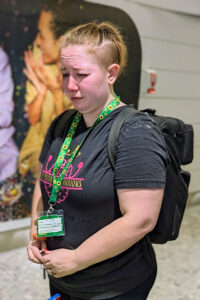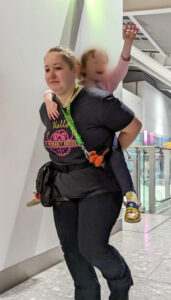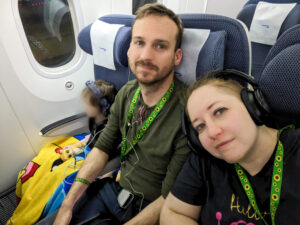Note from the Editor: This anecdote is about my child’s meltdown at the airport and it’s impact on me and our family. For their privacy and because they are not old enough to consent, I will not be sharing any media of them in distress. Their behavior was not their fault and was communicating sensory dysregulation in their body.
Trigger warnings: internalized ableism and thoughts of suicide
Traveling while disabled
Traveling is challenging enough as it is, but traveling while disabled comes with even more challenges. If you’ve ever traveled by plane, you might already be familiar with the airport accommodations for wheelchair users and those using mobile assistive devices (e.g., canes, crutches, walkers, etc.). Things like elevators and escalators as alternatives to walking up/down stairs, moving floors and transportation vehicles as alternatives to walking long distances, and escort(s) for every step of the way for passengers who are not independently mobile.
What you might not be familiar with are the accommodations for those of us with invisible disabilities. Some are well known, like those of us who are blind or deaf. Some are lesser known but physical, such as postural orthostatic tachycardia syndrome (POTS) and Ehlers-Danlos syndrome (EDS). But the least ones least considered by the general public are the neurocognitive conditions and mental illnesses with no visual indication such as autism, attention deficit hyperactive disorder (ADHD), post traumatic stress disorder (PTSD), etc. These are generally indicated by observable behaviors unless you believe someone’s explanation of their life experience (hence why self diagnosis is not just valid, but important).
If nobody can see (or believe) that you’re disabled, and especially if that disability affects how you communicate, then it can pose a barrier to accommodations, leading to a high-stress traveling situation. Which is what happened to our family as we traveled home to America from England.
Managing sensory health in children

I know my autistic 4-year-old child because I used to be an autistic child. I’m now an autistic adult. I also know them because I’m their parent and spend a lot of time with them and can see them for who they are, autism and all. I know their struggles with sensory sensitivities and their age-appropriate skills in patience. I know that waiting in a queue doing absolutely nothing else in an environment where you can’t control the noise, smells, or temperature is a recipe for sensory dysregulation.
I know that their little body will be under-stimulated and my child will become sensory seeking if nothing changes. With this knowledge, I have the ability to take preventative measures to keep our family’s sensory health… well… healthy!
So we left my partner (aka “Daddy”) to wait with our luggage while we took a stroll through the airport entrance. We were early for check-in so kiddo rode on Trunki that I dragged about, up and down the entire entrance and in many, many circles.
It was enjoyable for both of us. I got to walk calmly at my own pace without being weighed down by luggage and kiddo was safe. Many other passengers smiled at us as we walked about and I could sense envy in some of the other children who clearly didn’t want to walk either.
Once my kid got bored of this activity and decided they didn’t want to sit on Trunki anymore, I had to keep finding things to keep us occupied, things that were exciting enough for their senses that also didn’t put us in danger. Unfortunately, the only other thing in this area of the airport was some imagery on the floor and a photo op spot. After kiddo followed all the bridges painted on the floor, it was becoming increasingly urgent we go somewhere else.
Since I’ve been in this airport before, my next idea was that we go to the soft play area, however that is inside the terminal and we need to be checked in and go through airport security to access it. Now I said this was preventative. I even had the knowledge of how to prevent. There were even tools in place to prevent it, but I didn’t have all of that knowledge to know to use them. Hopefully by reading this story, you will.
Sensory overwhelm
Our kid ultimately became sensory seeking. They ran off under the ropes at the check-in lines and my partner went after them, bringing them back rather quickly and without incident. I saw an assistance lane and I thought it’d be worth a try to ask if we can check-in early so we can get to the soft play area sooner.
There were two employees standing at the start of the lane, talking to other passengers. I stood a short distance away, facing their direction hoping that they’ll notice me standing there and will talk to me once their conversation has ended.
That didn’t happen. Once that conversation was over, they continued talking to each other. I crept closer, because I’m autistic and interrupting conversations is something I can’t do very well, so I had hoped to make it more obvious that I wanted to talk to them. Instead, the one employee cheerfully went on break and the other remained. I thought, “this is my chance, please talk to me!”
They didn’t. Instead, they turned heel to approach other passengers that were queuing in this lane to essentially explain what this lane was for and turning them away because they did not meet the criteria, nor was check-in even open yet. I kept following them like a pet, dying for them to notice me, to notice my Sunflower lanyard. Meanwhile, my partner is struggling to hold our child in his arms as if they were a monkey, constantly pushing away from him and making noises with their mouth because they wanted the freedom to run.
After the employee turned away the entire queue of 2 groups, they saw me, smiled, and politely addressed me. I said to them that I have an autistic child who is struggling to wait and asked if we could check-in early so we can go to the soft play area. They asked where my child was and I turned and pointed to my family. Without hesitation, the staff member said yes, I thanked him, and briskly walked back to my partner and said we can check in.
This is where we made our first mistake. My partner put kiddo down and I decided, since they are at risk of running off, I decided it was paramount to put their identity bracelet with a Chipolo tracker attached on them. My child did not like this. My child did not want this. I felt beholden to a parenting duty that this was for their safety and it was going to go on them whether they wanted it to or not. This was the last straw for them and the meltdown began.
And yes, believe me, I blame myself for not being able to initiate conversations like other people. I often believe, as an autistic parent, as a mentally ill parent, as a disabled parent, that I’m inherently not a good parent because I can’t do the things I want to do like ask for help, ask for accommodations. Perhaps if I wasn’t disabled in such ways, I could’ve asked to check-in earlier, even before we went around with Trunki, and got to soft play 45 minutes sooner.
The autistic meltdown
My child laid on the floor of the airport screaming as if being tortured, contorting their small body in all sorts of ways to avoid having their identity bracelet and tracker put on them. Like a cruel parent, I got it around their ankle. Shoes were kicked off. I felt awful, so I took it back off. It’s apt that I describe it “as if being tortured” because that’s exactly what it was.
Meanwhile, my partner was grabbing our luggage and hauling it down the assistance lane to check us in. As I carried a bucking child across the front of my body like a pile of logs, the three of us weaved our way through people with zero situational awareness and made it to the desk. The moment I put kiddo down, they ran off in just their socks and I pursued.
I’m not particularly fast and I tried to be as polite as possible when forcing my way between people. Many people in the airport, I’ve found, seem to have tunnel vision. They don’t notice a tiny person 40 inches tall run past their legs so I appear to be the asshole unexpectedly pushing through them.
As I chase this speedster through a queue, under some ropes, and between desks, I hope with all my might that they don’t try to run through security or out the door into the wintry weather. Instead, they turned right and found themselves cornered in another airline’s check-in space where I managed to wrap my arms around them, scoop them up, and carry them back to Daddy checking us in.
Still flailing in my arms and screaming bloody murder, I sit myself on the floor by our luggage with a loose hold on our child. I don’t want to restrain their movement, I just don’t want them to run away. The two of us, in constant movement, kiddo is twisting about in my lap and removing the grip of one hand to get away as my other hand finds a new spot to hold onto and gently pull them back toward me.
I couldn’t bear to look at anyone. I just sat there, staring at the floor in front of me, occasionally looking at my struggling child as thought distortions took over…
- “Does my kid think I’m a bad parent?”
- “Am I traumatizing my kid right now?”
- “What would a good parent do?”
I endured a slap across the face, spitting in my face, hitting, hurtful words like, “I don’t want my family,” and three bites as I continued to spiral with anxiety…
- “I bet everyone here thinks my kid is a bad kid, they’re not bad…”
- “I bet everyone here thinks I’m a bad parent, they’re probably right”
- “My partner must be embarrassed by us…”
- “A neurotypical parent could handle this…”
When kiddo latched their mouth onto my left forearm and bit down as hard as they could, I could no longer keep my composure. Pain at this level is a trigger of mine. I screamed and jerked away, immediately embarrassed and in pain, I began to cry. Anxiety intensifies…
- “My partner probably regrets marrying me because I’m autistic and having an autistic child with me…”
- “Maybe I shouldn’t have had a kid because I’m autistic, I’m clearly not a good parent”
- “Can someone please take this kid? I can’t handle it anymore”
- “I want to disappear…”
- “Why the fuck is this check-in taking so long????”
I could overhear my partner telling someone that we are both autistic and I just couldn’t stop crying. I too was having a meltdown.
Autistic meltdown recovery: difference between an adult & child
After the people at the desk tried to bestow two toys to my child, which were promptly kicked away, an employee approached, knelt down to our level, and started talking to kiddo. I didn’t dare look at his face. Immediately, my child recoiled and curled up into me.
I am their safe person. They feel comfortable acting their true self with me but the moment someone who isn’t me or Daddy engages with them, they put on their autistic mask. To others, my little one appears shy, afraid of this stranger.
Now, I know this person had good intentions, but I hadn’t realized they were talking to me when they said, “Now be a good girl and stop crying.”
For one, I’m non-binary and not a girl. The card on my Sunflower lanyard has my pronouns. And for two, who are you to tell me to stop crying? I’m already anxious enough as it is and feeling embarrassed for crying in public so for you to say that just validates my fear: that crying is unacceptable in this situation. I completely ignored this and kept crying anyway. I couldn’t have stopped even if I wanted to.
He then asked my kid if they like chocolate. They nodded. He disappeared for a few minutes and returned with two chocolate bars. Their meltdown was sensory based, and chocolate is a lovely sensory stimulant. Kiddo stood up, accepted these gifts, and happily took them to show off to Daddy.
I sat there feeling like a useless lump. A lovely woman, another employee, extended her hand to me and helped me up. I still wouldn’t look at anyone in the face. Her voice soothing, no idea what she was saying as I couldn’t process oral information at this moment, but her arms opened up as if to offer a hug and I sank into her and cried into her shoulder, hugging her tightly as if we were long lost siblings being reunited for the first time in years. We were strangers.

She escorted us to a fast travel lane for security where she told a guy at a computer that I was distressed and then bid us farewell. He checked our passports and boarding passes and then directed us to follow the hall and turn left to the security checkpoint. My partner continued to care for our child as she was now happy as pie waiting to open her chocolate. You’d never have known she was in full meltdown only minutes earlier.
As for me, the pain lingered. As my anxieties from before continued to overwhelm me, new thoughts joined the party.
- “I can’t stop crying, why can’t I stop crying?”
- “I hope nobody asks me if I’m okay, I don’t know how to answer that right now”
- “Do I look suspicious because I’m crying?”
- “What did they just say?”
- “Why won’t my mouth work?”
- “What if I can’t hear/understand the security guard’s instructions?”
I wasn’t very capable of speech. Even when asked yes/no questions by my partner, I just nodded. I was currently a victim of situational mutism. It’s like the language processing sector of my brain just disconnected and I could barely understand what people said to me. I was very afraid something bad would happen, like I’d be flagged as suspicious because of my appearance and behavior and taken into questioning.

However, no such thing ever transpired. Despite my worries, everyone we interacted with allowed us to take our time and move slowly. Nobody asked me questions about my mental state and calmly (and almost cheerfully I might add) repeated their instructions when my face screwed up to convey confusion. When I’d make a look at my partner, he often clarified or said it louder and clearer so I could hear.
I have progressive, congenital hearing loss and an auditory processing disorder, so hearing and processing oral instructions is already challenging, but adding enough stress to put me in a disordered state amplifies those challenges to near impossible.
After a comforting hug from my little one, I felt the effects of stress start to melt away. Touch is important to me. Deep tissue pressure such as tight hugs really help my nervous system when it’s out of whack due to a CPTSD trigger. I wish I had gotten that woman’s name because her hug was the first best thing I received followed by the rest of the staff’s supportive treatment in getting us through security.
The lingering anxiety from my CPTSD slowly dissipated as we managed to find the soft play area in the terminal, which gave our kid a safe space to let loose their energy. My partner and I came up with a plan, one of us would get food and eat while the other stayed (no food allowed in the soft play area of course) and then we’d switch. Unfortunately, our plan never got off the ground because within 10 minutes of arriving in the soft play area, an airport staff member came to close the space for maintenance. She said it’d only be closed for 20 minutes, but it never reopened while we were there. So we had to make a new plan.
Everyone does the best they can with the tools they have
With a disappointed kid that’s still full of energy in a busy airport terminal and two hungry parents, one of which is recovering from a meltdown, we looked for an area of the airport that is semi-enclosed where kiddo can do whatever without disrupting too many others. We found a space in an unused gate where there was only one walkway to exit, so we shed our coats and backpacks and I flopped into a chair while our little one regulated themselves with spinning and running. Only once did I have to ask them not to lick the window and I was mildly amused by the passenger sitting on the other side who was briefly concerned they had been licked because they didn’t realize the window was there.
My partner came and went, mostly to have alone time, but also to get us food, chocolates, and coffee. Meanwhile, our kid fell in love with cheesy onion crisps and kept going into an enclosed space behind the lifts. They met another passenger waiting for their gate on the other side and kept going back there to offer them a crisp. Thank you, Stranger, for being so kind to them and letting my child feed you crisps through a gap in the windows. It really made kiddo’s day as they kept coming back to me with details on how they “met a girl” and wanted to share their crisps with her.
When it came time to go to our gate, kiddo was content to ride Trunki again so the walk there was rather uneventful. It was getting dark and as we approached the gate, a staff member at the counter looked at me, my lanyard, and my child, nodded, and met us at the roped off lane to let us through for early boarding. We made it through that and now all we needed to do left was wait to board.

As I said before, waiting is boring, especially for a neurodivergent child with lots of energy. I directed kiddo to look outside and how dark it was, and looked around at the sleeping babies in their strollers or worn on their adult’s body, and said we needed to do our best to be quiet since people are sleeping. Our kid is smart and kind and totally understood. They played their tablet with headphones on. All seemed to be working out.
But any parent will tell you that kids can only sit still for so long through no fault of their own. Once mine wanted to get up and move around, we tried playing a quiet came in the space together, one that didn’t have rules or make much sense; it was like hide and seek but but both of us were moving about around the pillar and statue, and the moment we made eye contact, we’d have to turn and go a different direction, as indicated by quiet giggles.
As quiet giggles got louder, we turned our attention to more controlled movement. I put them on my back and jogged around, adding a bounce in every step to stimulate our vestibular systems. No route in mind and rather random every time, especially as new passengers joined us in the space.
Our final activity before we were ready to board was the most extreme. I grab kiddo’s arms and they grab mine, and I spin so fast that their feet come off the ground. I become the centripetal force that creates the centrifugal force on my child’s body, and that is really stimulating for someone’s sense of equilibrioception.
Once we were on the plane, everyone was fine. We got to board early so nobody felt rushed or jostled around. Everyone took their time identifying what they needed to be comfortable and we managed an 8-hour flight with an autistic 4-year-old because of it (and well, because their sensory needs were finally met!).
Concluding Thoughts

I fully intend on writing to British Airways and the TSA to commend how supportive their staff had been once it was obvious we needed help, but also to send them this article to help them understand how important preventative measures are and why approaching someone wearing a Hidden Disabilities Sunflower Lanyard helps with that instead of waiting to be asked.
The sunflower lanyard could represent any invisible disability so a staff member may not know how to help someone who is wearing it, but it will go a long way if their training includes teaching them how to approach us and how to ask us if we need help and what they can do to help us.
10 days earlier when we were flying from Pittsburgh International to Heathrow, a TSA staff member overseeing security noticed I was wearing a sunflower lanyard and my husband was wearing the support lanyard. Completely unprompted, he approached my husband as he collected our items from the trays and offered assistance and information. We learned, without having to ask, that there was a sensory room in the terminal which my little one and I enjoyed exploring thereafter.
The Hidden Disabilities Sunflower initiative can work and I’m proud to be a wearer of the sunflower lanyard.
Products mentioned in this article
- Trunki, the ride-on suitecase for kids. Available to buy from their website and Amazon. Trunki is about $100 USD.
- Chipolo, a tracking device that comes with a free app that includes out-of-range alerts, no subscription required. Available to buy from their website, Best Buy®, and Amazon. One Chipolo “spot” device is $25-$30 USD.
- Hidden Disabilities Sunflower, a symbol that disabled people can choose to wear to discreetly indicate to the people around them that they have a hidden disability and may need additional support, assistance, or more time to complete a task. Lanyards are free when collected from a participating location and no diagnosis is required. Self-dx is valid.
Press
- Stephanie Hacke, “Alerting Others to Hidden Disabilities” (May 26, 2023). Mt. Lebanon Magazine.
- One Bad Mother, “Episode 494: If I Had a Nickel for Everything I Don’t Know About Autism, I’d Be Rich! with Tessa Watkins” (Mar. 16, 2023). Maximum Fun.
- Karen Schwartz, “Sunflowers are a hidden symbol for travelers with disabilities” (Mar. 9, 2023). The Washington Post.

